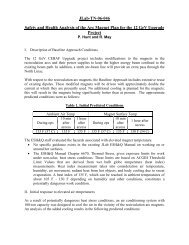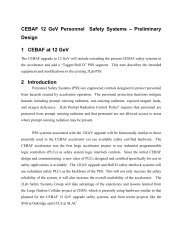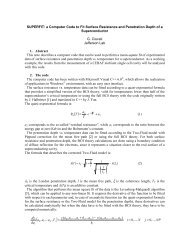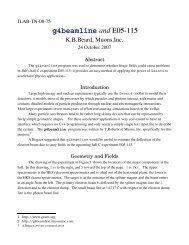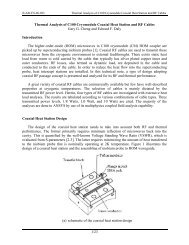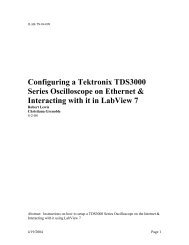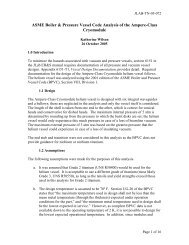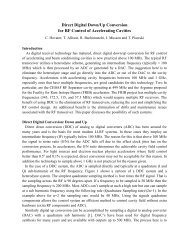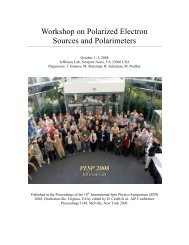âRotatorâ Into a Skew Quad Rotator - JLab Tech Notes Home Page
âRotatorâ Into a Skew Quad Rotator - JLab Tech Notes Home Page
âRotatorâ Into a Skew Quad Rotator - JLab Tech Notes Home Page
You also want an ePaper? Increase the reach of your titles
YUMPU automatically turns print PDFs into web optimized ePapers that Google loves.
JLAB-TN-04-0234 August 2004Reflections on <strong>Rotator</strong>s,Or,How to Turn the FEL Upgrade 3F <strong>Skew</strong> <strong>Quad</strong> “<strong>Rotator</strong>” <strong>Into</strong>a <strong>Skew</strong> <strong>Quad</strong> <strong>Rotator</strong>D. DouglasIntroductionA previous note [1] describes a simple skew quad system that can be used to exchangehorizontal and vertical motion in the IR Upgrade recirculator and thereby influence BBUthresholds. This system was devised and installed with the assumption that the relevantHOMs driving the instability would stimulate either pure horizontal or pure verticaldeflections, and could thus be counteracted simply by out-coupling the kick to the othertransverse plane.After successful operation of this system – with an increase of the observed BBUthreshold from around 2 mA to over 8 mA – it has been noted that it is in fact not a true“skew quad rotator” but rather is a “reflection”. It has further been noted that suppressionof BBU driven by HOMs of arbitrary polarization is desirable [2]. A thoroughquantitative investigation of the relationship between “reflections” and “rotations” isunderway [3]; here, we give only a simple method for converting the specific reflectioninstalled in the IR Upgrade into a true rotation.Reflections on <strong>Rotator</strong>sThe 3F “rotator” described in Reference [1] simply interchanges horizontal and verticalphase spaces, imaging each identically into the other. This is characterized by thefollowing transfer matrix, wherein the 2 x 2 off-diagonal sub-blocks M are identical andin this case betatron stable, imaging an upright ellipse (α=0) characterized by beamenvelope β back to itself in the other transverse plane.⎛ 0⎜⎝ MM0⎞⎟⎠withM⎛ cosψ⎜= 1⎜−sinψ⎝ ββ sinψ⎞⎟cosψ⎟⎠This will map a horizontal kick into the vertical plane, and a vertical kick to thehorizontal, and thus should suppress BBU driven by modes with these specificpolarizations. However, it will equally clearly map a diagonal displacement and kick(x,x’y,y’) back into a similar diagonal displacement and kick, thus potentially failing tosuppress BBU driven via an HOM of arbitrary polarization. We were however gently1 of 5
JLAB-TN-04-0234 August 2004reminded by Todd Smith [4] that earlier work [5] shows a true rotation – with a matrixinterchanging both planes with equal amplitudes but differing rotational phasing – willprovide the desired suppression. The task at hand is thus to convert the above matrix toone with the following form using components installed in the 3F region of the UpgradeDriver⎛ 0 µ M⎜⎝± M 0Introducing the desired sign differences immediately suggests use of the existing“rotator” led (and followed) by upstream (and downstream) decoupled transport ofrational phase advance – quarter wave, half wave, or full wave, to produce an overallsystem with the desired rotational phase properties. We note that that half- or full-wavetransport is described by –I or I, and quarter-wave can be described by the followingmatrix, where the leading notation is deliberately chosen to suggest a potential approach.⎞⎟⎠i=−I=⎛ 0⎜ 1⎜ −⎝ ββ ⎞⎟0 ⎟⎠Inspection of the situation then suggests a solution: Lead the “rotator” with a matrix thatis negative identity in one plane (half-wavelength) and a quarter wavelength in the other,trail it with a similar module with the planes exchanged. The net transfer matrix is theneither⎛ I⎜⎝00⎞⎛0⎟⎜i ⎠⎝MM ⎞⎛i⎟⎜0 ⎠⎝00⎞⎛ 0⎟ = ⎜I ⎠ ⎝iMM ⎞⎛i⎟⎜0 ⎠⎝00⎞⎛ 0⎟ = ⎜I ⎠ ⎝iMiM0⎞⎟⎠or⎛ i⎜⎝00⎞⎛0⎟⎜I ⎠⎝MM ⎞⎛I⎟⎜0 ⎠⎝00⎞⎛ 0⎟ = ⎜i ⎠ ⎝ MiM ⎞⎛I⎟⎜0 ⎠⎝00⎞⎛ 0⎟ = ⎜i ⎠ ⎝ MiMi⎞⎟0 ⎠The product of the 2 x 2 sub-matrices is evaluated under the assumption that the β in i isthe betatron stable “matched envelope” characteristic of the existing eigenmode exchangemodule.⎛ 0 β ⎞⎛cosψβ sinψ⎞⎛0 β ⎞ ⎛ − cosψ− β sinψ⎞⎜ ⎟⎜⎟⎜⎟ ⎜⎟iMi = 1 11⎜ ⎟⎜⎟⎜⎟= 1⎜⎟= −M− 0 − sinψcosψ− 0 sinψ− cosψ⎝ β ⎠⎝β⎠⎝β ⎠ ⎝ β⎠The resulting matrices thus have the desired form of a true rotation:2 of 5
JLAB-TN-04-0234 August 2004⎛ 0 µ M⎜⎝± M 0We note that full wave (I) and three-quarter wave (-i) will work equally well, should thatbe otherwise called for.⎞⎟⎠ImplementationThis section is called “Implementation” rather than “Practical Implementation” forspecific reasons. See the “Comments” below.To convert the 3F region to a pure rotation, we first recall that the preferred polarity is asshown in Figure 1, and the installed system is configured (during “reflector” operation) asin Figure 2. We can lead with –I in either plane and a quarter-wave in the other, for thepurposes of this example we chose to start with the half wave in the horizontal. After a bitof fiddling, we found that an additional pair of quads was useful in making the upstreamand downstream telescopes symmetrical and to get a robust match. Given thisconfiguration (Figure 3) it was trivial to obtain the desired characteristics and get anoverall transfer matrix that was a pure rotation (Table 1).Figure 1: “Natural” 3F configurationFigure 2: 3F with reflection activatedFigure 3: 3F with rotation activated; nonexistent elements in blue.3 of 5
JLAB-TN-04-0234 August 2004Table 1: DIMAD output for 3F transfer matrix in rotator (rather than reflector) mode. Theelements M 14 , M 23 , M 32 , M 41 match to only the 5- or 6-digit level because that’s theresolution used to set the beta value in fitting for the quarter-wave transform.******************************* TRANSFORMATION MATRIX *******************************FIRST ORDER MATRIX- 0.7443778E-15 0.1101679E-14 -0.7397106E+00 -0.3300114E+01 0.0000000E+00 0.0000000E+00- 0.1075734E-15 -0.7345646E-15 0.1372159E+00 -0.7397106E+00 0.0000000E+00 0.0000000E+00- 0.7397106E+00 0.3300006E+01 -0.6019490E-15 -0.6425416E-14 0.0000000E+00 0.0000000E+00- -0.1372204E+00 0.7397106E+00 -0.8326673E-16 -0.2220446E-15 0.0000000E+00 0.0000000E+00- 0.0000000E+00 0.0000000E+00 0.0000000E+00 0.0000000E+00 0.1000000E+01 0.0000000E+00- 0.0000000E+00 0.0000000E+00 0.0000000E+00 0.0000000E+00 0.0000000E+00 0.1000000E+01CommentsThe only skew elements are the embedded reflectionThis is an exercise only; I wouldn’t necessarily recommend running off and installing thetwo extra quads for four reasons. Firstly, they might not absolutely be necessary; thecomputation was done using telescopes with two triplets simply because we knew wecould get the answer quickly. We haven’t checked to be sure we can’t do it with adoublet/triplet configuration. Secondly, this demonstration doesn’t actually solve theright problem: we really want a rotation from an unstable cavity back to itself, not justacross the backleg. The appropriate unstable cavity hasn’t, however, yet been identified,and, even if it were, knowledge of the polarization of the offending mode would beneeded and could in fact be such that a reflection, or even just a simple shift in phaseadvance, would provide adequate operational control of the instability. Thirdly, even ifthe matrix is right, the internal details of the transport could preclude successful machineoperation. Though the instability might be suppressed by the appropriate choice ofmatrix, the envelope mismatch internal to the system could potentially be severe enoughthat performance could be loss-limited, not instability limited.Finally, additional quads may well not be required to meet the desired conditions. With30 other main quadrupoles available in the linac and recirculator, it is valid to questionwhether imposing the constraint that 3F be a pure rotation (with potential nasty internalmismatch) is the right operational approach. One may do better simply by running therotator as we do now – using the upstream and downstream quads to match into and outof it, and using the 2F and 5F telescopes to massage the overall transfer matrix into theproper form.We note that operational practice often ignored BBU-imposed constraints altogether.Were we instability limited (to, say 1 or 2 mA) we frequently just tuned up the transportsystem to be better matched and thereby adequately cured the instability limit as well(that is, we pushed it out to over 5 mA).4 of 5
JLAB-TN-04-0234 August 2004AcknowledgmentsThanks to Geoff Krafft for trying to get us to pay attention to this, and to Todd Smith forsucceeding in getting us to pay attention to this. Be sure to study Eduard Pozdeyev’streatment of the reflection/rotation; the initial note looks great and it will be donerigorously, generally, and in detail. Thanks to Chris Tennant for causing the ruckus tobegin with by documenting BBU suppression in the Upgrade.References[1] D. Douglas, “A <strong>Skew</strong>-<strong>Quad</strong> Eigenmode Exchange Module (SQEEM) for the FELUpgrade Driver Backleg Transport”, JLAB-TN-04-016, 12 May 2004.[2] G. Krafft initially attempted to instruct us of this. As always, he was ignored. T.Smith, however, is NOT to be ignored, and wasn’t, when he brought it up. T.Smith, private communication; E. Pozdeyev, private communication andunpublished note; C. Tennant et al., to be presented at the 2004 FEL Conference(Trieste, Aug. 2004)[3] E. Pozdeyev, work in progress.[4] Op. cit.[5] Rand, R.E. and T.I. Smith, “Beam Optical Control of Beam Breakup In ARecirculating Electron Accelerator”, Particle Accelerators, Vol. 11, pp.1-13,1980.5 of 5



